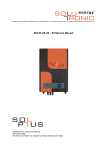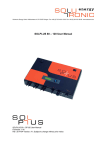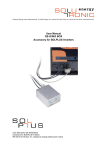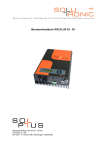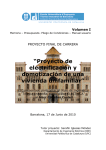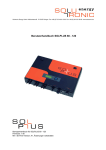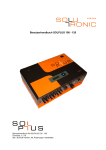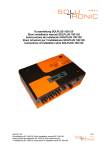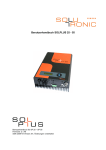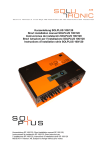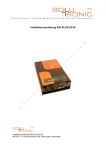Download SOLPLUS 25 – 55 User Manual
Transcript
r SOLPLUS 25 – 55 User Manual SOLPLUS 25 – 55 User Manual Firmware: 2.64 MV/ 2012-11 Version: B8, Subject to change without prior notice SP25-55_User Manual_B8_EN_2012-11-06 2/32 Contents 1 Notes About The User Manual ....................................................................................................... 4 Scope.......................................................................................................................................... 4 More information......................................................................................................................... 4 Abbreviations .............................................................................................................................. 4 Symbols used in this document.................................................................................................. 5 2 Safety .............................................................................................................................................. 6 2.1 Safety in general......................................................................................................................... 6 2.2 Intended use ............................................................................................................................... 6 2.3 Safety instructions ...................................................................................................................... 6 2.4 Non-observance of this User Manual ......................................................................................... 7 2.5 Nameplate .................................................................................................................................. 8 3 Introduction ................................................................................................................................... 10 4 General communication features.................................................................................................. 10 5 Operating states............................................................................................................................ 13 6 Display navigation SOLPLUS 25 - 55........................................................................................... 14 7 Communication with the Inverter Via the RS232 Port .................................................................. 15 8 Communication With the Inverter Via the Ethernet Port and Webbrowser .................................. 15 9 Communication with Several Inverters by means of Master-Slave Data Communication ........... 15 10 SOLPLUS+ Communication Software .......................................................................................... 15 11 Files of the inverter ....................................................................................................................... 16 12 Communication with SolarLog™ .................................................................................................. 17 13 Sensor Connections...................................................................................................................... 17 14 Yield Monitoring ............................................................................................................................ 18 14.1 Integrated energy meter....................................................................................................... 18 14.2 Annual energy logger ........................................................................................................... 18 14.3 Connecting an external energy meter .................................................................................. 18 14.4 Operating hours meter ......................................................................................................... 20 14.5 Integrated yield monitoring................................................................................................... 20 15 Integrated Installation Monitoring.................................................................................................. 21 15.1 Possible causes of an alarm ................................................................................................ 21 15.2 Horn...................................................................................................................................... 23 16 Data Logger .................................................................................................................................. 23 17 Functions of the Relays and Analogue and Digital Inputs and Outputs ....................................... 24 17.1 Function of relay 1................................................................................................................ 24 17.2 Function of relay 2................................................................................................................ 25 17.3 Analogue inputs ................................................................................................................... 26 17.4 Analogue outputs ................................................................................................................. 26 17.5 Digital inputs......................................................................................................................... 27 17.6 Digital outputs....................................................................................................................... 28 18 Password Protection ..................................................................................................................... 29 18.1 Customised protection of the inverter settings..................................................................... 29 19 Resetting to Default Settings ........................................................................................................ 29 20 Other Parameters ......................................................................................................................... 30 21 Large External Display.................................................................................................................. 32 22 Analogue or GSM Modem ............................................................................................................ 32 1.1 1.2 1.3 1.4 SP25-55_User Manual_B8_EN_2012-11-06 3/32 Notes About The User Manual 1 Notes About The User Manual Dear Customer, Thank you for buying a SOLPLUS solar inverter designed and manufactured by Solutronic. This manual describes how to user your SOLPLUS inverter. Please keep it somewhere where you have ready access to it whenever you need to. Please comply at all times with the safety precautions we refer to in this manual. In order to keep the description short, the section on communication deals mainly with the details of display communication. For all other means of communication, reference is made to the relevant manuals. You can carry out all parameter settings described here using any of the different means of communication available. 1.1 Scope This User Manual applies to the following Solutronic inverters: SOLPLUS 25, SOLPLUS 35, SOLPLUS 50, SOLPLUS 55. 1.2 More information The following documents and software are provided on the accompanying CD and in the download area of www.solutronic.de and can be used as a reference guide on how to operate your new inverter: The CD contains the following documents and software: • • • • • • • SOLPLUS 25 – 55 Fitters' Manual DimenSOL+ dimensioning tool (program for designing PV installations) SOLPLUS+ communication software (for the PC) and user manual Instructions for GSM/analogue modem (remote monitoring) Instructions for sensor installation (installation of sensor connections) Instructions for master-slave data network/yield monitoring Instructions for Ethernet browser The SOLPLUS inverters have been developed, manufactured and tested with great care and are incorporate the very latest technology. Our manufacturing procedures are in accordance with the stipulations of ISO 9001. If you encounter any problems or have any questions, please do not hesitate to get in touch with us. Solutronic AG Küferstrasse 18 D-73257 Köngen [email protected] www.solutronic.de 1.3 Abbreviations The following abbreviations are used in this manual: SP 25 SP 35 SP 50 SP 55 = = = = SOLPLUS 25 – 55 SOLPLUS 35 – 55 SOLPLUS 50 – 55 SOLPLUS 55 – 55 SP25-55_User Manual_B8_EN_2012-11-06 4/32 Notes About The User Manual SOLPLUS+ = Read-out and monitoring software for use with all Solutronic inverters DC = AC = PV Generator = = Direct current (direct voltage): electrical value on the input side of the inverter Alternating current (alternating voltage): electrical value on the output side of the inverter Photovoltaic Solar generator: interconnection of several solar modules to form a string or a number of parallel strings Password level -1 Password level 1 Password level 2 Passwort Level 3 Passwort Level 4 measured value, cannot be changed client installer Safety Master 1.4 Symbols used in this document Please read and observe the following safety instructions in this manual. The danger classes describe the risks of non-observance of the safety instructions. (The safety instructions describe the following danger classes per ANSI.) Attention! "Attention!" denotes a warning that, if not observed, can result in property damage! Caution! "Caution!" denotes a warning that, if not observed, can result in personal injury! Warning! "Warning!" denotes a warning that, if not observed, can result in death or serious injury! Danger! "Danger!" denotes a warning that, if not observed, will result in death or serious injury! Note Useful information and tips to help you operate the SOLPLUS inverter to best effect. SP25-55_User Manual_B8_EN_2012-11-06 5/32 Safety 2 Safety 2.1 Safety in general Please read the following safety information and instructions before you put the SOLPLUS inverter into operation for the first time, in order to avoid personal injuries and/or property damage. These instructions must be complied with at all times. Do to attempt to install or put the SOLPLUS inverter into service until you have read through all the documentation supplied thoroughly. Read through these safety instructions and all other user instructions and tips before you begin work with this device. If you sell on, hire out or pass on this device to someone else in some other way, make sure that you give the new user these safety instructions, too. 2.2 Intended use This device must be used only for the purpose described in this User Manual. The inverter is designed for use in grid-connected photovoltaic installations. All safety regulations must be complied with. All installation work must be carried out precisely as described in this manual. No modification of any kind to or in this device or to its external wiring is permitted. Any such modification could lead to serious safety problems and danger to life and limb. 2.3 Safety instructions Warning! Improper use of these devices, non-observance of the warnings given in this manual and improper tampering with the safety functions can lead to property damage, personal injury, electric shock and, in extreme cases, death. Caution! The surface of the inverter housing can become hot when the inverter is in operation. Very hot! Do not touch! Danger! High voltage due to incorrect connection! Risk of fatal or bodily injury from electric shock. SP25-55_User Manual_B8_EN_2012-11-06 6/32 Safety 2.4 Non-observance of this User Manual Solutronic AG shall accept no liability for damages resulting from non-observance of the warnings given in this User Manual. Read the operating, maintenance and safety instructions before you put the device into operation for the first time. If you are not able to understand the language used in this documentation sufficiently, please contact and inform the supplier of the situation. Trouble-free and safe operation of this inverter presumes proper, professional and workmanlike transportation, storage, mounting and installation as well as careful operation and thorough maintenance. Notice Solutronic AG is not liable for the consequences arising from faulty installation of the inverter! Among these consequences are: • Damage to the display and keyboard foil, deterioration of readability • Fading of the print on the housing, the look of the housing deteriorates Therefore, chose the place of installation for the inverter so that the device is not directly or indirectly exposed to UV radiation: • The device must not be exposed to direct sunlight • The device must be protected from reflections by glass facades or PV modules SP25-55_User Manual_B8_EN_2012-11-06 7/32 Safety 2.5 Nameplate You can identify the model of your inverter by looking at the nameplate. The nameplate, which carries the precise type designation of the inverter, is located on the right-hand side of the housing. The example is valid for SOLPLUS 25 – 55. Nameplate of a SP 35 S/N 0938-0001 SP 35, IP 21 MC4 MAC: 0021EC050001 SP25-55_User Manual_B8_EN_2012-11-06 8/32 Safety 2.5.1 Explanation of the symbols used on the nameplate The nameplate provides the following information: Attention! Hot surfaces! Attention and danger! Observe the operating instructions!! Waste Electrical and Electronic Equipment (WEEE) Solar inverters must not be disposed of with household waste. Please return the device to Solutronic after it has reached the end of its useful life. Attention! The inverter may still carry voltage even after it has been disconnected from the PV installation and grid. Please be sure to wait until the capacitors have fully discharged (discharge period). S/N 0938-0001 SP 35, IP 21 MC4 MAC: 0021EC050001 • • • • Production date and serial number Inverter model and degree of protection Connectors at DC end MAC address of integrated Ethernet port SP25-55_User Manual_B8_EN_2012-11-06 9/32 Introduction 3 Introduction Each SOLPLUS inverter features a number of interfaces and communication ports via which the data of the inverter can be read out. A total of approximately 300 inverter parameters can be read out. The data provided by the inverter are divided into the following categories: 1 Yield and display values: These values represent the instantaneous values of the inverter. They are actual values and display values that cannot be altered. 2 Setting values: These are values that can be set and altered individually. Depending on the importance and meaning of the parameters, these values can be set by the final customer, the fitter or the utility company. For security purposes, different password levels are incorporated. 4 General communication features 3 9 11 10 8 6 4 5 2 1 7 SOLPLUS 25 - 55 1 RS232 X1 7 2 RS485 X2 8 3 4 5 6 Slot for option cards 9 Ethernet X7 DC switch DC connections External connector X4 10 Additional PE connection External terminal strip X5 11 DC connections Auxiliary power supply X6 Note An external plug-in AC adapter can be used to provide an auxiliary power supply. 12 V DC 300 mA, with built-in modem 1 A Connector, 5.5 x 2.1 pin + (positive), sheath – (negative) SP25-55_User Manual_B8_EN_2012-11-06 10/32 General communication features Parameter 265: COM1 log type Menu: Unit: Resolution: Default setting: Password level: Communication/Basic settings --1 0 1 Parameter 265 defines which protocol is used for communication via the standard port, COM1, of the inverter. COM1 is both the 9-pin SubD female connector X1 for RS232 and also the 3-pin terminal strip X2 for RS485. The signals for X1 and X2 are connected together in circuit in the inverter. This means that it is not possible to use different protocols via the standard RS232 and the standard RS485 at the same time. General notes on parameter 265: Value Meaning 0 ASCII protocol (for using the inverter with HyperTerminal) 1 Solutronic protocol (for using the inverter with SOLPLUS+). N.B.: Leave parameter 265 set to the value 0; 0 = ASCII protocol is automatically switched internally to 1 = Solutronic protocol 2 Debug function. Do not use. 3 Modem with ASCII protocol 4 Modem with Solutronic protocol. N.B.: When operating via modem, leave parameter 265 set to the value 3; 3 = Modem with ASCII protocol is automatically switched internally to 4 = Modem with Solutronic protocol 5 Not active 6 Not active 7 GSM modem with ASCII protocol 8 Not active 9 SolarLog protocol for SolarLog™ data logger Note SolarLog™ and Solutronic's master-slave data communication function can not be used at the same time. SP25-55_User Manual_B8_EN_2012-11-06 11/32 General communication features Parameter 266: COM2 log type Menu: Unit: Resolution: Default setting: Password level: Communication/Basic settings --1 0 1 Parameter 266 defines which protocol is used for communication via the second COM2 port of the device. COM2 is accessible in the form of the RS232 port at X4 (25-pin SubD female connector). The option card (modem, RS485) is also connected via COM2. The signals for X4 or the option cards are connected together in circuit in the inverter. This means that it is not possible to use different protocols via the second RS232 and the option cards. The following settings are possible: Value Meaning 0 ASCII protocol (for using the inverter with HyperTerminal) 1 Solutronic protocol (for using the inverter with SOLPLUS+). N.B.: Leave parameter 266 set to the value 0; 0 = ASCII protocol is automatically switched internally to 1 = Solutronic protocol 2 Debug function. Do not use. 3 Modem with ASCII protocol 4 Modem with Solutronic protocol. N.B.: When operating via modem, leave parameter 266 set to the value 3; 3 = Modem with ASCII protocol is automatically switched internally to 4 = Modem with Solutronic protocol 5 Large RiCo display 6 Large Schneider display 7 GSM modem with ASCII protocol 8 Not active 9 SolarLog protocol for SolarLog™ data logger Note SolarLog™ and Solutronic's master-slave data communication function can not be used at the same time. N.B.: If you want to operate the inverter directly and locally using a PC, please use the 0 setting (default setting). In this case, it is unimportant whether you use RS232 or RS485 to establish a link with the inverter or the inverter's data network. Automatic switch-over of the type of protocol from 0 to 1 (i.e. from operation with HyperTerminal to operation with SOLPLUS+) cannot be reversed. To do so, the inverter would have to be reset, i.e. switched off and on again. The same applies to automatic "switch-over" of the type of protocol from 3 to 4 (i.e. from modem operation with HyperTerminal to modem operation with SOLPLUS+). If the protocol setting is 3, 4, 5 or 6, this port cannot be used directly with HyperTerminal or SOLPLUS+. To do so, the corresponding parameter has to be reset either by means of the display or via the other port. SP25-55_User Manual_B8_EN_2012-11-06 12/32 Operating states 5 Operating states The operating states of the SOLPLUS 25 - 55 inverters are indicated by means of a light-emitting diode (LED) and on the display. The LED has two colours and indicates the instantaneous operating state of the inverter. The actual operating state is indicated on the display. For the operating state to be identified, the DC side of the inverter must be connected to the PV modules and a minimum voltage of approx. 280 V must be input into the inverter. Example SOLPLUS 25 – 55 display LED P 1 Production date Meaning the operating states LED Explanation Constantly lit green Grid-feed mode Flashing green Initialisation or standby, e.g. because the voltage of the solar generator is too low SOLPLUS 50 PAC=0W Initialisation Menu ► Flashing red/green Fault has occurred SOLPLUS 50 PAC=0W Initialisation Menu ► or Restart in progress Constantly lit red Fault in at least one phase of the inverter Display content SOLPLUS 50 PAC=2510 W Grid-feed mode Menu ► SOLPLUS 50 PAC=0 W Grid failure Menu ► What to do in the case of a fault If the LED on the inverter lights up red or red/green, read up the fault description in the Installation Instructions manual or note down the warning/alarm/fault message indicated on the display and contact your fitter. It is best if you read out all the data supplied by the SOLPLUS inverter: the last fault displayed, fault memory, data logger and list of all parameters. SP25-55_User Manual_B8_EN_2012-11-06 13/32 Display navigation SOLPLUS 25 - 55 6 Display navigation SOLPLUS 25 - 55 Base window: by pressing a button the display turns on and the main screen appears. The basic menu is accessed by pressing the down arrow key on the display. In the basic menu, the yield values can be read. By pressing the arrow key left, you return to the base window. The main menu is accessed by pressing the arrow key to the right. Before entering the main menu, the password is requested. The sequence (up/right/down/up/right/down), confirmed with “OK”, enters the main menu. Inside the main menu you could modify in several submenus the desired parameters. By pressing the left key, you return to the base window. The actual value menu could be accessed by pressing the arrow key left. It is separated into four menu groups. Inside, you could access several parameters. By pushing the arrow key left again, you reach the following menus. At the end you get back to the base window. (more information on the display menu can be found on the CD and the download section at www.solutronic.de). Basic configuration Password request Actual value menu INPUT DC voltage DC current power DC 231 V 7,6 A 1794W Actual value menu Actual value menu SOLPLUS 35 PAC : 3416 W grid-feed mode Menu Basic menu INPUT INVERTER YIELD MONITOR Main menu Basic menu energy today OUTPUT Enter password Press key combination and Confirm with OK Main menu 0,0kWh energy total 0,0kWh amount euro today 0,0€ amount euro total 0,0€ firmware version 1,29 SPP Address 2 IP: 192.168.0.99 - 11:56:17 (time) - 15.12.2011 (data) - Device Configuration Safety Power Reduction Reactive Power Communication slave data Datalogger installation data Maintenance annual energy logger Yield control Options SP25-55_User Manual_B8_EN_2012-11-06 14/32 Communication with the Inverter Via the RS232 Port 7 Communication with the Inverter Via the RS232 Port All that is required to connect the inverter to a PC is a serial connection cable. Only pins 2, 3 and 5 are relevant in respect of the wiring in the cable. The cable should be no more than 15 metres long. The PC or laptop to be connected must have an RS232 port. If the computer is equipped with just a USB port, a USB–RS232 port adapter cable must be used. Data are read out by means of the SOLPLUS+ or HyperTerminal software. 8 Communication With the Inverter Via the Ethernet Port and Webbrowser With the help of a PC, you can use the Ethernet link to control the inverter via a web browser or Solutronic's communication software SOLPLUS+. Provided that your converter is connected to a network and has been configured correctly, you can call up and read out data from your inverter via any PC connected to the network. N.B.: Internet Explorer has difficulties displaying carriage returns and line feeds in text files. We therefore recommend you use Mozilla Firefox as the web browser. If you are interested in setting up this form of communication, please load the instructions for the Ethernet browser from the CD supplied or download them from www.solutronic.de. 9 Communication with Several Inverters by means of Master-Slave Data Communication The master-slave data communication function is used to network up to 32 inverters in an installation. For this purpose, the inverters must be connected to each other via the standard RS485 port. One of the inverters in the installation is defined as the "data master". The display of this inverter then shows the most important data (the data of the basic menu). The "data master" also records the current power level and the yields of the "data slaves" and adds them together. If you are interested in setting up this form of communication, please load the instructions for masterslave data communication from the CD supplied or download them from www.solutronic.de. 10 SOLPLUS+ Communication Software SOLPLUS+ is a Windows program for evaluating inverter data and incorporates the following basic functions: • Configuration of the inverter • Connection to the inverter via RS232, Ethernet and modem • Easy configuration of an installation: you can store different configurations, i.e. different installations. For example, you can monitor an installation with 2 inverters on your roof via RS232 or RS485. You can then load a new configuration to call up and monitor an installation that consists of 10 inverters via modem. • In the same way as with the display, you can use SOLPLUS+ to configure your inverter how you want to. You can also use the PC to enter a password and then change settings that are not relevant to safety. • Modification and implementation of the various "files" that the inverter supplies: list of all parameters, fault memory, annual energy logger etc. SOLPLUS+ reads out the data logger and transfers the data to the PC. The values to be read out and displayed must be selected individually by the user. All parameters can be read out. Simple operator control and a Help function make it possible to monitor how your PV installation is functioning and its yield. SP25-55_User Manual_B8_EN_2012-11-06 15/32 Files of the inverter If you are interested in using SOLPLUS+ to monitor your inverter, please load the program and the installation and user manuals of SOLPLUS+ from the CD supplied or download them from www.solutronic.de. 11 Files of the inverter The inverter generates various "files", which can be read out via one of its communication ports and communication modes. File number 0 1 Name No file Fault memory 2 List of all parameters 5 List of actual values 6 Data logger 7 Annual energy logger 8 Annual sensor logger 9 Annual sensor/energy logger 10 (A) 13 (D) Configuration of data logger Installation monitoring 14 (E) Alarms Description The fault memory – a list of the last 100 faults, with date, time and fault number. These are stored in the sequence in which they occurred (with date and timestamp). A table showing all the parameters of the inverter, with parameter number, parameter name, parameter value and unit A table showing all parameters and the actual values, i.e. values which can be changed The data logger: entries with a time stamp and values of the parameters A table in the form of a ring memory (endless loop memory) about the preceding year with the achieved yield of each respective day in kWh. Resolution: 0.1 kWh A table in the form of a ring memory (endless loop memory) about the preceding year with the achieved "theoretical yield" of the insolation sensor (if connected) on each respective day in kWh. Resolution: 0.1 kWh A table in the form of a ring memory (endless loop memory) relating to the preceding year, with the achieved yields of the inverter and the insolation sensor (if connected) on each respective day in kWh. Resolution: 0.1 kWh A description of the configuration (contents) of the data logger with the estimated storage times A list with the yield values of the master, insolation sensor and all slaves as well as the yield values of the master, sensor and all slaves relative to the connected nominal DC output. This list is in the form of a ring memory (endless loop memory) and has been created over the course of the preceding year. It cannot be read until the integrated yield monitoring function has been started and successfully ended (see chapter entitled "Yield monitoring") A list of the alarms which occurred on this day. These are stored in this file in the sequence in which they occurred. Additional information as well as the time are also stored here The above files can be created and read out using SOLPLUS+ or the web browser. SP25-55_User Manual_B8_EN_2012-11-06 16/32 Communication with SolarLog™ 12 Communication with SolarLog™ The data logger known as SolarLog™ from Solare Datensysteme GmbH can be used to network up to 32 inverters in an installation. Please note that SolarLog™ and Solutronic's master-slave data communication function cannot be used at the same time. For communication with SolarLog™ the inverters and SolarLog™ must be connected to each other via the standard RS485 port. Note the pin assignments of the RS485 connectors, which differ as follows: RS485 A (+) RS485 B (-) Masse SP100 / 120 M12 farbcodiert weiß schwarz blau SP100 / 120 M12 2 4 3 -frei- SP25 - 55 3polig 1 (links) 2 (mitte) 3 (rechts) SP25 -55 Patch 3 (gn/ws) 6 (gn) 1+2 (or or-ws) SolarLog 1 4 3 2 Weitere Information zum Betrieb und zur Einstellung von SolarLog finden Sie im „Installationshandbuch Solarlog“ auf www.solutronic.de. 13 Sensor Connections A large number of different sensors can be connected to the inverter. The following sensor types are currently supported: Manufacturer Type/Model Remark Mencke & Tegtmeyer Si-01TC Insolation sensor with internal lithium battery Usage conditional due to limited service life of the battery Mencke & Tegtmeyer Si-01TCext Insolation sensor Mencke & Tegtmeyer Si-01TC-T Tritec Spektron 300 Insolation sensor with temperature sensor, see description of parameter 209 Insolation sensor This list is constantly being added to. Please contact us if you would like information on a type/model of sensor that is not in the list above. If you interested in connecting sensors, please load the corresponding instructions on connecting sensors from the CD supplied or download them from www.solutronic.de. You will also find additional information there. SP25-55_User Manual_B8_EN_2012-11-06 17/32 Yield Monitoring 14 Yield Monitoring 14.1 Integrated energy meter The inverter is equipped with an integrated energy meter that calculates and adds up the energy fed into the mains power supply (accuracy: approx. 1.5%). N.B.: The energy meter of the inverter deliberately indicates a value approx 1.5% lower than that actually fed into the grid. The purpose of this is to ensure the inverter does not indicate to you, the owner, a value that is higher than that recorded by the actual "calibrated" export meter of your power supplier. Parameter 8: Energy today Menu: Unit: Resolution: Default setting: Password level: Actual values/Yield monitor kWh 0,001 kWh 0 1 This displays the amount of energy fed into the grid so far today. N.B.: The value is not saved and the amount of energy fed in during the whole day is displayed shortly before it becomes dark. Parameter 12: Energy total Menu: Unit: Resolution: Actual values kWh 1 kWh This parameter is used to display the total amount of energy the inverter has fed into the power supply system since its installation. Parameter 29: Compensation Euro per kWh Menu: Unit: Resolution: Default setting: Password level: Yield control €/kWh 0,0001 €/kWh 0.287€/kWh 1 This parameter displays the currently applicable compensation per kW/h of energy supplied to the grid. 14.2 Annual energy logger The inverter records the daily yield for every day of the year. The inverter is equipped with a memory that stores the yield for 365 days. This memory is cyclical, i.e. after a year, it overwrites the old values stored. The annual energy logger can be read out via any of the available communication ports. You call up the annual energy logger in the display from the basic menu. 14.3 Connecting an external energy meter To enable additional monitoring of yield, it is also possible to connect an external energy meter (electricity meter) with S0 output (prerequisite) directly to the inverter. This external energy meter may be the actual export meter used by the utility company to record the amount of electricity fed into the grid. Due to the fact that the internal energy meter of the inverter is deliberately inaccurate, the option of connecting an external energy meter enables the exact value the PV installation actually yields to be recorded and displayed. The external energy meter output pulses via the S0 output, which the inverter detects and records. Connecting the external energy meter to connector X4 of the inverter: SP25-55_User Manual_B8_EN_2012-11-06 18/32 Yield Monitoring The connector pin assignments are as follows: X4, pin 13 Positive connection of the S0: output of the energy meter. Maximum voltage: 5 V; maximum current: 16 mA X4, pin 23 Ground = negative connection of the S0: output of the energy meter The following parameters are used for configuring and displays: Parameter 127: SO-counter pulse per kWh Menu: Unit: Resolution: Default setting: 2000 Password level: Options/basic settings --1 1 This parameter specifies how many pulses the external energy meter supplies per kWh. This value can be found on the external meter itself and it must be entered here under this parameter to ensure correct calculation. N.B.: In some cases, the amount of energy per pulse is also given on the meters. Examples: • 0.5 Wh/pulse equates to 2000 pulses/kWh • Wh/pulse equates to 500 pulses/kWh Parameter 128: SO-counter pulse Menu: Unit: Resolution: Actual values/Yield monitor --1 This parameter counts the actual number of pulses input and is used for internal calculation. The value of this parameter is regularly saved to guard against loss in the event of a power failure. Parameter 151: SO-counter energy Menu: Unit: Resolution: Actual values/Yield monitor kWh 1 kWh If an external energy meter is connected and parameter number 127 is set accordingly, the energy measured by the external (S0) energy meter is displayed. Parameter 222: SO-counter power Menu: Unit: Resolution: Actual values/Yield monitor W 1 This displays the power currently being measured by the external (S0) energy meter. Note that the power value displayed is always time-delayed and rounded off because it has to be back-calculated from the number of pulses. This parameter can be used to display the power of a "neighbouring installation" or "external installation" in an installation equipped with Solutronic inverters (e.g. for a large external display). SP25-55_User Manual_B8_EN_2012-11-06 19/32 Yield Monitoring Parameter 224: SO-counter energy day Menu: Unit: Resolution: Actual values/Yield monitor kWh 0,001kWh This displays the "day yield", i.e. the yield on a particular 'today', measured by the external (S0) power meter. This parameter can be used to display the day yield of a "neighbouring installation" or "external installation" in an installation equipped with Solutronic inverters (e.g. for a large external display). Parameter 225: SO-counter pulse today Menu: Unit: Resolution: Actual values/Yield monitor --1 The number of S0 pulses measured 'today' is accurately recorded here. 14.4 Operating hours meter The inverter uses the following parameters to display the number of operating hours: Parameter 123: Operating hours today Menu: Unit: Resolution: Actual values/Yield monitor h (Stunde) 0,1 h Parameter 123 displays the length of time the inverter has already been switched on today. The meter starts running as soon as the solar generator delivers an adequate voltage. Parameter 124: Operating hours total Menu: Unit: Resolution: Default setting: Password level: Actual values/Yield monitor h (Stunde) 0,1 h --4 Parameter 124 records and stores the total length of time the inverter has been switched on since it was first started up. 14.5 Integrated yield monitoring Each inverter is equipped with and capable of activating an integrated yield monitoring function. This function is based on the comparison of yield data either from one inverter with an insolation sensor connected or from an installation comprising at least 2 inverters that are networked by means of their RS485 ports. Details of how the yield monitoring function works can be found in the instructions for the master-slave data network and in those for the sensor. Both manuals can be found on the CD supplied or can be downloaded from www.solutronic.de. Your dealer can supply you with the activation code. SP25-55_User Manual_B8_EN_2012-11-06 20/32 Integrated Installation Monitoring 15 Integrated Installation Monitoring Each inverter is equipped with an integrated installation monitoring function. This means it regularly performs a number of checks and warns the installation's owner in the event of a critical condition arising or variations in yield occurring. If the inverter detects a critical condition or yield variation, it continues to function – insofar as this is possible – but outputs an alarm both visually and acoustically. An alarm is given by the following means: • Acoustic alarm: the alarm horn integrated in the inverter emits an intermittent alarm tone. It sounds for half a second every second. The alarm horn can be switched off by pressing any button. • The LCD display switches on. The word "Alarm" and the cause of the alarm are displayed alternately in the third line of the basic (start) screen. • The LED on the cover of the inverter flashes red and green alternately. • The number of the alarm is also displayed in parameter 155 (in the Installation Monitoring menu). If the inverter is being operated via a communication port, a file that is continuously written to and has the name "File 14 Alarms" can be read out. This file is empty in the morning and, insofar as (several) alarms occur during the course of the day, has the various alarm texts, additional explanations and the times at which the alarms occurred written to it. 15.1 Possible causes of an alarm The following causes of an alarm are possible: Alarm Description number 0 No alarm 1 UAC not okay. This text is displayed if the mains voltage is lower than the minimum alarm threshold or higher than the maximum alarm threshold for the mains voltage for longer than 2 minutes. 2 UDC too high. This text is displayed if the DC voltage is higher than the maximum DC voltage alarm threshold for longer than 1 minute. Inverter too hot. This text is displayed if the inverter temperature is higher than 65°C for longer than 2 minutes. Yield sensor. This text is displayed if the yield monitoring function (see section on yield monitoring) has detected during the last 5 days a variation between the yield of the inverter and the "theoretical yield" of the sensor that exceeds the value of P280. Yield slaves. This text is displayed if the yield monitoring function (see section on yield monitoring) has detected during the last 5 days a variation between the yield of the inverter and the yield of the slave that exceeds the value of P280. Communication. This text is displayed if data communication between the master and the slaves is disrupted. Mains frequency. This text is displayed if the variation from the rated mains frequency of 3 4 5 6 7 SP25-55_User Manual_B8_EN_2012-11-06 Dependent upon Attribute represents: - Bit of P279 - P50: Max. mains voltage alarm threshold; P52: Min. mains voltage alarm threshold P58: Max. DC voltage alarm threshold Value of the mains voltage 0 Value of the DC voltage 1 Value of the inverter temperature - 2 P280: Yield variation P280: Yield variation P76: Max. alarm threshold 3 Number of the slave 4 Number of the slave 5 Value of the mains 6 21/32 Integrated Installation Monitoring 50 Hz is higher than the alarm threshold for this variation for longer than 5 minutes. 8 9 Frequent faults. This text is displayed if, during the past 2 hours, the same fault has occurred more than 3 times in succession or if more than 6 different faults have occurred. External. This text is displayed if an external alarm has been tripped. Parameter 279: Configuration warning Menu: Unit: Resolution: Default setting: Password level: Maintenance --1 383 1 for variation from rated frequency of 50 Hz frequency Number of the fault (fault code) 7 - 8 Each of the 9 alarms described above can be activated or deactivated separately. Parameter 279 is bit-programmed, i.e. each of its bits activates or deactivates one of the 9 alarms. 8 7 6 5 External Frequent Grid Commuwarning faults frequency nication 1 0 1 1 1 0 1 0 1 1 1 0 4 Yield slaves 1 1 1 3 2 1 Yield Temperat UDC too sensor ure high 1 1 1 1 1 1 1 1 1 0 = Bit UAC not = decimal OK 1 = 383 1 = 351 1 = 479 Example: The installation comprises several inverters that are networked by means of their RS485 ports. However, since the PV generators of the installation have very different orientations (i.e. point in different directions), integrated yield monitoring is to be performed but no alarm is to be given in the event of a variation in yield. All other alarms, however, are to remain active. This means that bits 0, 1, 2, 3, 5, 6, 7 and 8 are to remain set, but bit 4 must be deleted. This results in a binary value for P279 of 111101111, which equates to a decimal value of 495. P279 must therefore be set to 495. Parameter 155: Status warning Menu: Unit: Resolution: Maintenance --1 Parameter 155 displays the alarm (warning) currently active. You can find details in the table above. Please note that only the first alarm given on the particular day is displayed. If further alarms occur during the course of the day, they are not recorded as subsequent or secondary alarms. SP25-55_User Manual_B8_EN_2012-11-06 22/32 Data Logger 15.2 Horn Parameter 45: Function signaller Menu: Unit: Resolution: Default setting: Password level: Options/Basic settings --1 0 1 Possible settings: Value = 0 Value = 1 Value = 2 Value = 3 The signal generator generates an intermittent tone when an alarm is given. The signal generator generates an intermittent tone as long as the inverter is suffering from a fault and is deactivated. If the cause of the fault is no longer present and the inverter begins a new activation check, the intermittent tone stops being emitted. The signal generator generates an intermittent tone when an alarm is given. The signal generator generates a continuous tone as long as the inverter is suffering from a fault and is deactivated. If the cause of the fault is no longer present and the inverter begins a new activation check, the continuous tone stops being emitted. The signal generator generates an intermittent tone when an alarm is given. The signal generator is always Off. 16 Data Logger The data logger of the SOLPLUS inverters is freely programmable, that is, the logging intervals and content of the data logger can be freely programmed. The following parameters define the data logger: Parameter 130: Data logger cycle Menu: Unit: Resolution: Default setting: Password level: Data logger min 1 5 min 1 The clock pulse can be set between 1 and 60 minutes. Parameter 133 – 140: Parameter 1 DL - Parameter 8 DL Menu: Unit: Resolution: Default setting: Password level: Data logger Parameternummer 1 2 1 Default settings: P133 = 2 DC voltage of the PV generator P134 = 5 Current amount of power being fed into the grid by the inverter P135 = 16 Temperature of the inverter P136 = 0 P137 = 0 P138 = 0 P139 = 0 P140 = 0 In the default settings, 3 parameters are stored per clock pulse, each parameter comprising 2 bytes. This means that around 5,000 data entries can be recorded in a 5-minute raster before the memory is overwritten by the new data ("ring memory"). SP25-55_User Manual_B8_EN_2012-11-06 23/32 Functions of the Relays and Analogue and Digital Inputs and Outputs In the case of a 5-minute clock pulse and e.g. 14 hours of sunshine, approx. 168 entries are generated every day. After roughly 29 days, the data logger is full and begins overwriting the first data entries stored: these entries should therefore be read out before they are overwritten. The inverter's memory for logger data has a storage capacity of 30 Kbytes. Possible settings: The 8 parameters available can be used to configure the content of a data logger line as desired. The minimum parameter number in each case is 0, the maximum number 254. Please refer to the appendix for the parameter numbers. Note that the list of parameters from 133 to 140 begins with values that are not zero. The first entry that is 0 means the end of the logger list. The inverter now creates "files" every day, which the inverter saves to guard against loss in the event of a power failure. N.B.: After you have changed the configuration of the data logger (that is, the content of parameters 133 to 140), you have to delete the entire data logger memory. You do this by setting parameter 66 "Set default values" to the value 70 = Delete data logger. All changes to the settings of the data logger can be made under password level 1 (Customer). 17 Functions of the Relays and Analogue and Digital Inputs and Outputs 17.1 Function of relay 1 Parameter 46: Relays 1 function Menu: Unit: Resolution: Default setting: Password level: Output control --1 1 1 Relay 1 has one N.O. and one N.C. contact. The relay can be used to forward messages to external units. This relay can also be used to implement alarm (warning) and fault alarm functions. Other functions will follow in the future and you may send us suggestions or requests for such functions. The contact rating is 230V AC or 30V DC, max. 5 A. The connector pin assignments are as follows: (Pin 1 is on the left) X5, pin 1 Relay 1, two-way contact COM X5, pin 2 Relay 1, N.O. contact X5, pin 3 Relay 1, N.C. contact SP25-55_User Manual_B8_EN_2012-11-06 24/32 Functions of the Relays and Analogue and Digital Inputs and Outputs 17.2 Function of relay 2 Parameter 47: Relays 2 function Menu: Unit: Resolution: Default setting: Password level: Output control --1 0 1 Relay 2 has just one N.O. contact. The relay can be used to forward messages to external units. This relay can also be used to implement alarm (warning) and fault alarm functions. Other functions will follow in the future and you may send us suggestions or requests for such functions. The contact rating is 230V AC or 30V DC, max. 5 A. The connector pin assignments are as follows: (Pin 1 is on the left) X5, pin 4 Relay 2, two-way contact COM X5, pin 5 Relay 2, N.O. contact Relais 1 X5.3 X5.1 Relais 2 X5.4 X5.2 X5.5 Contacts illustrated deenergised Possible settings for parameters 46 and 47: Value = 0 Value = 1 Value = 2 Value = 3 Value = 4 Value = 5 Value = 6 Value = 7 Value = 8 Value = 9 Relay 1 or 2 always deenergised. The COM and N.O. contacts are always open. The COM and N.C. contacts are always closed. Relay 1 or 2 is energised as long as the inverter is suffering from a fault and is not operating. In this case, the COM and N.O. contacts are closed and the COM and N.C. contacts open. Relay 1 or 2 is energised as long as the inverter is not suffering from a fault and is operating. In this case, the COM and N.O. contacts are closed and the COM and N.C. contacts open. Relay 1 or 2 is energised as long as the inverter displays an alarm. In this case, the COM and N.O. contacts are closed and the COM and N.C. contacts open. Relay 1 or 2 is energised as long as the inverter is not displaying an alarm. In this case, the COM and N.O. contacts are closed and the COM and N.C. contacts open. Relay 1 or 2 is energised as long as the inverter displays an alarm or a fault. In this case, the COM and N.O. contacts are closed and the COM and N.C. contacts open. Relay 1 or 2 is energised as long as the inverter is not displaying an alarm or a fault. In this case, the COM and N.O. contacts are closed and the COM and N.C. contacts open. Relay 1 or 2 is energised if the inverter temperature (parameter 16) is higher than 50°C. If the inverter temperature falls below 48°C, the relay in question is deenergised. Relay 1 or 2 is energised if the inverter temperature (parameter 16) is higher than 55°C. If the inverter temperature falls below 53°C, the relay in question is deenergised. Relay 1 or 2 is energised if the inverter temperature (parameter 16) is higher than 60°C. If the inverter temperature falls below 58°C, the relay in question is deenergised. SP25-55_User Manual_B8_EN_2012-11-06 25/32 Functions of the Relays and Analogue and Digital Inputs and Outputs Value = 10 Value = 11 Value = 12 Value = 13 Value = 14 Value = 15 Value = 16 Relay 1 or 2 is energised if the inverter temperature (parameter 16) is higher than 65°C. If the inverter temperature falls below 63°C, the relay in question is deenergised. Relay function is reserved for the de-icing option. Relay 1 or 2 is energised as long as the inverter is suffering from the fault "3-phase VDEW fault" and is not operating. In this case, the COM and N.O. contacts are closed and the COM and N.C. contacts open. The relay function is deactivated in night mode. Relay 1 or 2 is energised as long as the inverter is not suffering from the fault "3-phase VDEW fault" and is operating. In this case, the COM and N.O. contacts are closed and the COM and N.C. contacts open. The relay function is deactivated in night mode. Relay 1 or 2 is energised as long as the inverter is suffering from a fault and is not operating. In this case, the COM and N.O. contacts are closed and the COM and N.C. contacts open. The relay function is deactivated in night mode. Relay 1 or 2 is energised as long as the inverter is not suffering from a fault and is operating. In this case, the COM and N.O. contacts are closed and the COM and N.C. contacts open. The relay function is deactivated in night mode. Relay 1 or 2 is constantly energised. 17.3 Analogue inputs Parameter 22: Analogue input 1 Menu: Unit: Resolution: Actal values/Sensor V 0,01 Parameter 23: Analogue input 2 Menu: Unit: Resolution: Actal values/Sensor V 0,01 The two analogue inputs can be used to feed signals from external sensors or other similar devices into the inverter and to display them by means of parameters 22 and 23. The connector pin assignments are as follows: X4, pin 7 Analogue input 1, 0 to 10 V X4, pin 8 Analogue input 2, 0 to 10 V X4, pin 19 or 20 Ground reference for analogue inputs The maximum input voltage is +/- 30V. 17.4 Analogue outputs Each inverter is equipped with 2 analogue outputs: 0 to 10 V, maximum output current = 4 mA. Parameter 298: Function of analogue output 1 Menu: Unit: Resolution: Default setting: Password level: Output control ----0 1 SP25-55_User Manual_B8_EN_2012-11-06 26/32 Functions of the Relays and Analogue and Digital Inputs and Outputs Parameter 299: Function of analogue output 2 Menu: Unit: Resolution: Default setting: Password level: Output control ----0 1 Possible settings for analogue outputs 1 and 2: Value = 0 Set output to 0 V Value = 1 Set output to DC voltage (UDC). 400 V correspond to 4.00 V Value = 2 Set output to DC current (IDC). 5.00 A correspond to 5.00 V * Value = 3 Set output to DC current (IDC). 12.00 A correspond to 6.00 V Value = 4 Set output to AC current (IAC). 5.00 A correspond to 5.00 V * Value = 5 Set output to AC current (IAC). 12.00 A correspond to 6.00 V * Value = 6 Set output to AC current (IAC). 22.00 A correspond to 5.50 V Value = 7 Set output to AC power fed to grid (PAC). 500 W correspond to 5.00 V * Value = 8 Set output to AC power fed to grid (PAC). 1,200 W correspond to 6.00 V * Value = 9 Set output to AC power fed to grid (PAC). 3,000 W correspond to 7.50 V * Value = 10 Set output to AC power fed to grid (PAC). 5,000 W correspond to 5.00 V Value = 11 Set output to DC power (PDC). 500 W correspond to 5.00 V * Value = 12 Set output to DC power (PDC). 1,200 W correspond to 6.00 V * Value = 13 Set output to DC power (PDC). 3,000 W correspond to 7.50 V * Value = 14 Set output to DC power (PDC). 5,000 W correspond to 5.00 V Value = 15 Set output to temperature of inverter. 50°C correspond to 5.00 V Value = 16 Set output to temperature of modules. 50°C correspond to 5.00 V, but only above 0°C Value = 17 Set output to external temperature. 50°C correspond to 5.00 V, but only above 0°C Value = 18 Set output to insolation. 800 W/m² correspond to 8.00 V * Value = 19 Set output to insolation. 1,200 W/m² correspond to 6.00 V Value = 20 Set output to PAC of installation. 8,000 W correspond to 8.00 V * Value = 21 Set output to PAC of installation. 55,000 W correspond to 5.50 V * These values may overflow when the upper limit is reached. The connector pin assignments are as follows: X4, pin 1 Analogue output 1, 0 to 10 V X4, pin 2 Analogue output 2, 0 to 10 V X4, pin 14 Ground reference for analogue inputs 17.5 Digital inputs The inverter is equipped with 2 voltage-free (isolated) digital inputs. Their level can be displayed by means of parameters 35 and 36. Parameter 35: Digital input 1 Menu: Unit: Resolution: Actal values/Sensor --1 SP25-55_User Manual_B8_EN_2012-11-06 27/32 Functions of the Relays and Analogue and Digital Inputs and Outputs Parameter 36: Digital input 2 Menu: Unit: Resolution: Istwerte/Sensorik --1 The connector pin assignments are as follows: (Pin 1 is on the left) X5, pin 6 Digital input 1 X5, pin 7 Digital input 2 X5, pin 8 Ground reference for digital inputs 1 and 2 Important: The digital inputs are isolated from all other terminals and connections of the inverter. The maximum voltage difference between the digital inputs and protective earth conductor is 250 V. The maximum voltage allowed to be applied to the inputs is 32 V. 17.6 Digital outputs The two outputs supply 10 to 15 V when in state "1" and are short-circuit-proof. The maximum current is approx. 40 mA. Parameter 157: Digital output 1 Menu: Unit: Resolution: Default setting: 0 Password level: Output control --1 1 The connector pin assignments are as follows: X4, pin 15 Digital output 1 X4, pin 14 Ground reference for digital output 1 Parameter 158: Digital output 2 Menu: Unit: Resolution: Default setting: Password level: Output control --1 0 1 The connector pin assignments are as follows: X4, pin 16 Digital output 2 X4, pin 17 Ground reference for digital output 2 Possible settings for digital outputs 1 and 2: Value = 0 Digital output 1/2 is always "0" Value = 1 Digital output 1 or 2 is "0" as long as the inverter is suffering from a fault and is deactivated. If the cause of the fault is no longer present and the inverter begins a new activation check, the digital output is "1" again. Value = 2 Digital output 1 or 2 is "1" as long as the inverter is suffering from a fault and is deactivated. If the cause of the fault is no longer present and the inverter begins a new activation check, the digital output is "0" again. SP25-55_User Manual_B8_EN_2012-11-06 28/32 Password Protection 18 Password Protection 18.1 Customised protection of the inverter settings To protect the inverter and its parameter settings against unauthorised changes, it is possible to assign an access code to the inverter. This is especially important if your inverter is "freely accessible" via a modem or the internet. Since the password for parameters of password level 1 is the serial number of the inverter, anyone – in theory – can change your parameter settings. To prevent this from happening, the following parameters can be used: Parameter 267: Access code 1 Menu: Unit: Resolution: Default setting: Password level: Device configuration --1 0 1 Parameter 267 is configured such that it indicates the current access setting when it is read: When reading parameter 267: Value = 0: Access not possible When reading parameter 267: Value = 1: Access is possible If you enter access code 1 for parameter 267, access to the inverter will in future be blocked and no changes will be able to be made without first entering access code 1 again. To protect the parameter settings of the inverter, proceed as follows: Set the password level to 1 by entering the relevant password. Now enter access code 1 for parameter 267 and make a note of this setting. Then enter a different, incorrect value (any value) for parameter 267 in order to activate the lock once you have finished your work. Your inverter is now locked and protected. To regain access to the inverter and its parameters, enter your access code for parameter 267, carry out your work and when finished, deliberately enter an incorrect value again for parameter 267. N.B.: It is not possible to read out the numbers entered as access code 1! You must therefore make a note of these numbers and keep them safe! If, however, you do happen to forget or lose these numbers, the inverter can only be re-enabled again by the manufacturer. In this case, Solutronic will provide you with a special code that will enable you to reset the access code. 19 Resetting to Default Settings Parameter 66: Set standard value Menu: Unit: Resolution: Default setting: Password level: Device configuration --1 0 1 Parameter 66 resets settings to their default setting, i.e. the values set when the inverter was first delivered (delivery status): Possible settings: Value = 10 If you set parameter 66 to the value 10, all parameters covered by password level 1 are reset to their default settings (delivery status). To enable this function, you have to set password level 1 (Customer) beforehand. Value = 20 If you set parameter 66 to the value 20, all parameters covered by password level 2 are reset to their default settings (delivery status). To enable this function, you have to set password level 2 (Fitter) beforehand. Value = 70 If you set parameter 66 to the value 70, the data logger will be deleted. To enable this function, you have to set at least password level 1 (Customer) beforehand. SP25-55_User Manual_B8_EN_2012-11-06 29/32 Other Parameters Value = 73 Value = 74 If you set parameter 66 to the value 73, the total yield meter (parameter 108 or 12) will be deleted. To enable this function, you have to set at least password level 2 (Fitter) beforehand. If you set parameter 66 to the value 74, the sensor total yield meter (parameter 217 or 219) will be deleted. To enable this function, you have to set at least password level 2 (Fitter) beforehand. 20 Other Parameters Setting the date and time To change the date, time and day of the week, go to the main menu item Inverter, select the "Date" or "Time" option, press the OK button and then change the settings. Use the ◄ or ► button to select the digit to be changed and then use the ▲ or ▼ button to change the value. The date/time you have set is adopted when you press the OK button. Note: The time in the display is only updated when you reselect the corresponding menu. The changed time, however, is adopted accurately to the second. When entering the weekday, the following convention applies: 0 = Sunday, 1 = Monday, etc. Parameter 122: Maximum power today Menu: Unit: Resolution: Actual values/output W 1W Parameter 122 indicates the maximum power level fed into the grid today. Parameter 147: Device class Menu: Unit: Resolution: Default setting: Password level: Device configuration --1 50 4 The following inverter models are currently available: Value Description 25 SOLPLUS 25 IP 21 with display 26 SOLPLUS 25 IP 54 with display 35 SOLPLUS 35 IP 21 with display 36 SOLPLUS 35 IP 54 with display 50 SOLPLUS 50 IP 21 with display 51 SOLPLUS 50 IP 54 with display 55 SOLPLUS 55 IP 21 with display 56 SOLPLUS 55 IP 54 with display SP25-55_User Manual_B8_EN_2012-11-06 Nominal inverter output 2500 W 2500 W 3500 W 3500 W 4600 W 4600 W 5000 W 5000 W 30/32 Other Parameters Parameter 148: Serial number Menu: Unit: Resolution: Default setting: Password level: Device configuration --1 0 4 Parameter 148 displays the serial number of the inverter. Parameter 161: Waiting time grid okay Menu: Unit: Resolution: Default setting: Password level: Safety/Basic settings sec 1 30 sec 2 Parameter 161 sets the time that must elapse following a grid fault (grid voltage or grid frequency not OK) before the inverter reconnects to the grid. For Germany (VDE 0126), a delay of 20 sec. is stipulated. Other settings may be required in other countries. Parameter 259: General configuration Menu: Unit: Resolution: Default setting: Password level: Device configuration --1 0 1 By setting bit 0 = "Take external energy meter into account" to 1, the yields and power values recorded by the external energy meter are included in the cumulative installation values of the following parameters: P197 Total CO2 reduction (of installation) P198 Energy total of installation P199 Power of installation (AC output) P221 Energy of installation today • By setting bit 1 = "LCD constantly On" to 1, the LCD remains constantly switched on. If you set this bit to 0, the LCD switches itself off after 20 minutes if no button is pressed. • By setting bit 2 = "LCD-LED constantly On" to 1, the backlight of the LCD remains constantly switched on. If you set this bit to 0, the backlight switches itself off after 2 minutes if no button is pressed. • By setting bit 3 = "Write fault 7 to fault memory" to 1, a fault with fault code 7 = "UDC too low" is entered in the fault memory. If you set this bit to 0, this "fault" – which inevitably occurs every day in the morning and evening, often repeatedly, due to the output of the PV generator being too low – is not entered in the fault memory. This means the fault memory does not fill up so quickly. • By setting bit 4 = "Reset" to 1, the inverter performs a restart (reset). • By setting bit 5 = "S0 pulses in SEJL" to 1, the "day yields" recorded by an external electricity meter connected to the S0 pulse input are saved to the annual sensor energy logger instead of the "sensor yields". This function enables the yields of an "external installation" to be saved to the installation with Solutronic inverters. See also parameters 127, 128, 151, 222, 224 and 225. • By setting bit 6 = "Adopt data for large display", this slave of an installation has the data for the large display of a master written to it. SP25-55_User Manual_B8_EN_2012-11-06 31/32 Large External Display Example for parameter 259: You want fault 7 = "UDC too low" to be entered in the fault memory nevertheless. Bit 3 of the parameter must be set; this corresponds to the value 8. So set parameter 259 to the value 8. Parameter 271: Display Parameter Menu: Unit: Resolution: Default setting: Password level: Device configuration --1 0 1 If you set parameter 271 to a value that is not 0, the parameter with this parameter number will be constantly displayed on the third line in the basic (start) screen of the display. Example: You want to see the value of parameter 8 = Energy today displayed constantly on the display without having to press a button. To do this, set parameter 271 to the value 8. 21 Large External Display A large external display can be connected directly to the inverter by means of the optional second RS485 port or the optional radio module. If you would like more information on this, please contact Solutronic directly. 22 Analogue or GSM Modem Solutronic inverters can be equipped with analogue or GSM modems for monitoring purposes. Option cards are available for both possibilities (analogue or GSM), which you can order from us through your dealer. We strongly recommend you use the internal option cards, although a standard external analogue modem can also be connected. The internal option cards have a far lower power consumption than external solutions. What's more, they also mean there is no extra wiring or installation work necessary, at least if you order the option card together with the inverter. Detailed documentation on connecting and parameterising the modem solutions can be found on the CD supplied or can be downloaded from www.solutronic.de. Solutronic AG Küferstrasse 18 D-73257 Köngen Tel.: 07024/96128-0 Fax: 07024/96128-50 [email protected] www.solutronic.de SP25-55_User Manual_B8_EN_2012-11-06 32/32
































